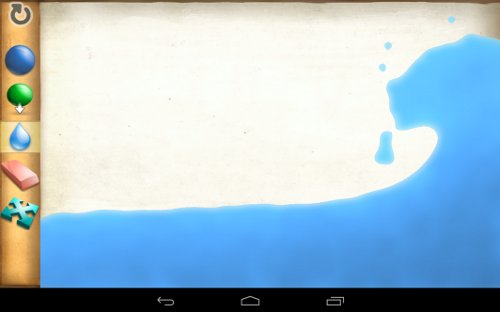This document describes how to set up a Java project to use LiquidFun. It has the following sections:
- Overview
- Installation: How to install SWIG.
- Build Instructions: How to include LiquidFun JNI in your project.
- Sample: A Java program that uses LiquidFun's SWIG bindings.
- Programmer's Guide: A discussion on how this differs from using LiquidFun in native C++ code.
Overview
A subset of the LiquidFun API has been exposed to Java via SWIG bindings. The SWIG interface files have the .swig extension. They are located in Box2D/swig/java. For convenience, the file structure mirrors the file structure of Box2D.
Some LiquidFun header files are not pulled directly into SWIG. This allows users to pull in only the functionality they need. This, in turn, reduces the number of JNI bindings produced.
Installation
Current SWIG version tested: 2.0.11
To learn more about SWIG, and to install it, please visit their website.
On Linux, you also must install PCRE, as SWIG depends on it:
apt-get install libpcre3-dev
Set up an environment variable to point to your SWIG installation. One way to do this (on Linux, OSX, or Cygwin) is to add the following to your ~/.bashrc file:
export SWIG_BIN=$("which" swig)
Build Instructions
Using LiquidFun JNI in your Eclipse Android project
Include the library in your jni/Android.mk file as a shared library:
LOCAL_SHARED_LIBRARIES := libliquidfun_jni
include $(BUILD_SHARED_LIBRARY)
$(call import-add-path,/path/to/liquidfun/)
$(call import-module,Box2D/swig/jni)
This will invoke SWIG, and build the C++ components of the library.
Next, launch Eclipse, and perform the following steps:
- Right-click project > Properties.
- Click on "Java Build Path" on the left panel.
- In the Source tab, click "Link Source..."
- Browse to the
Box2D/swig/genfolder, and give it a name.
You should now be able to build and run your application using LiquidFun. All generated Java files reside in Liquidfun/Box2D/swig/gen. You can refer to these files to confirm class, method, and other names.
Caution
LiquidFun JNI uses the SWIG director feature, which can introduce the following compiler error:
error: dereferencing type-punned pointer will break strict-aliasing rules [-Werror=strict-aliasing]
To ensure a successful build, you will need to disable strict-aliasing in your makefile. For an Android project, add -fno-strict-aliasing to your Application.mk file.
Sample
The open source app LiquidFun Paint is written in Java, and uses LiquidFun via SWIG bindings.

Programmer's Guide
The LiquidFun SWIG interface files pull in a subset of the LiquidFun API, extends it, and presents it in a way consistent with typical Java style.
Function and Variable Renames
- All b2 class name prefixes have been removed.
- All function names have been converted to mixedCase.
- All m_ member variable prefixes have been removed.
- All b2 enum name prefixes have been removed.
Memory Management
JVM (Java Virtual Machine) uses garbage collection to clean up memory, which is very different from the user-managed memory model in C++. The following points are critical in order to facilitate efficient JNI memory management.
Use the delete() method in generated Java classes
The user must use the SWIG-generated delete() method to clean up all LiquidFun objects exposed through SWIG. This is because SWIG-generated (Java) proxy classes–not the JVM–are allocating C++ memory through every new object.
For example:
BodyDef* bodyDef = new BodyDef();
...
`bodyDef.delete();
For a member variable that is a native object:
private World mWorld = new World(0, 0);
...
@Override
protected void finalize() {
mWorld.delete();
}
Use primitive types whenever possible
Because the user has to be conscientious about cleaning up any new objects, directly exposing to Java a C++ function signature like
void SetPosition(const b2Vec2& pos);
will create this method:
void setPosition(Vec2 pos);
This method requires that the user creates Vec2 objects. Since Vec2 objects are native objects, you must clean them up using a delete() method, which can be quite unwieldy when you are initializing large amounts of data.
Instead, use SWIG to extend the interface. Do this by adding a new function to the corresponding SWIG interface file:
extend b2ParticleDef {
void setPosition(float32 x, float32 y) {
$self->position.Set(x, y);
}
};
This file generates the following Java code:
void setPosition(float x, float y);
which allows the user to call the function with primitive types (in this case, floats) directly.
Starting from LiquidFun 1.1, the existing extended SWIG methods have been moved to LiquidFun header files. These methods will be wrapped with the LIQUIDFUN_EXTERNAL_LANGUAGE_API preprocessor. This is so we could provide users with a unified API regardless of the programming language they elect to use.